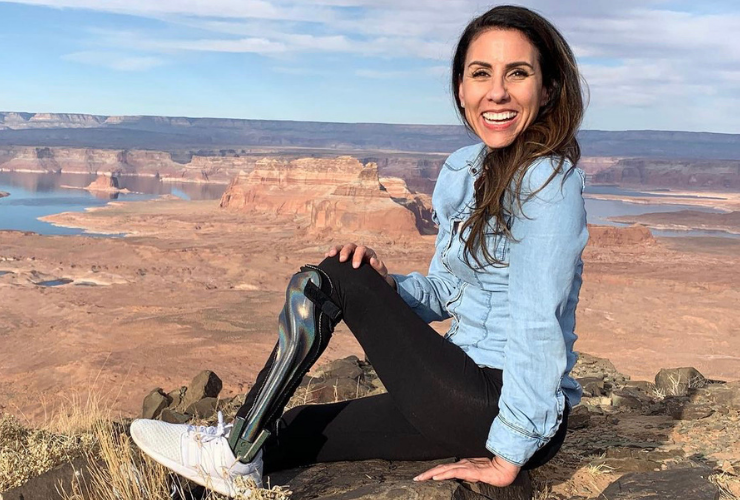Meet Estela Lugo who is a Disability Advocate, Hereditary Neuropathy Foundation Program Development, Speaker + Educator. We first discovered Estela in this CFDA Adaptive Fashion Series. We recently went live on Instagram with Estela which is a great introduction to the below Q&A!
Talk to us about your self-love and embracing it journey.
Like most of us, my journey started in childhood. My parents never projected shame onto my sister and me around our disability and instead began overnight advocates. We grew up surrounded by passionate and mission-driven families like ours and learned the importance of community. It wasn’t until my middle school and teenage years that I became more and more self-conscious of my disability.
I just wanted to fit in. I wanted to wear cute skirts and dresses to dances. I wanted to join sports and dance teams like every other girl my age. I carried these insecurities into my late 20’s as a young mom and designer. It wasn’t until I came across a powerful documentary called, Bernadette, that I saw someone that looked like me, speaking openly about my disease (Charcot-Marie-Tooth or CMT). It completely shifted my mindset from hiding to advocating for myself and others.
Talk to us about the importance of representation.
There is immense impact in representation! I wouldn’t be in this line of work without it. Representation shows us that something can be done. It’s a mirror of sorts that reflects our own potential. I always admire individuals that are brave enough to break those barriers for themselves and others.
Let’s talk about dating with a disability.
Dating can be challenging without a disability. When we carry shame around our own disabilities or societal stigmas around disability in general, then we miss out on the opportunity to find deep connections. Like all of us, a successful relationship is founded on a healthy sense of self-worth.
Like we often say on our podcast, everyone has stuff. When we approach dating in this frame of mind, then disability can be an opportunity to be vulnerable and a common ground to build on. Confidence is attractive on anyBODY. Plus, disabled people are awesome and sexy AF!
What kinds of shoes would work well for someone who wears leg braces?
Ahh, I lost count of how many times I came home in tears after shoe shopping as a child. For starters, shoes that are 100% flat are often overlooked. Most flats/boots or sneakers still have some kind of incline which affects the locked position of our ankles, making it more difficult to walk/stand.
Wide widths are also super helpful as most braces can be bulky and hard to slip into a traditional shoe/boot. Lastly, zippers, zippers, zippers (or magnets)! Full length and multiple zippers make all the difference in our ability to put and take off footwear. Ideally, closures with looped pulls allow for those of us with fine motor challenges to grip them with much more ease.
Going forward, what are some things designers should be thinking about in terms of adaptive fashion?
The most important thing, consulting and working with people with disabilities throughout the entire process (including marketing)!
Let’s talk about your extremely important message of repurposing our pain.
We all carry some form of pain in our lives, whether that took place in our childhood or as adults. As difficult as these events and circumstances are, they are also opportunities for growth and can become roadmaps for others to navigate through similar experiences. In simple terms, become the person you once needed for others. I break down the full process in my TEDx Talk!
How do you want to be viewed in the world?
The disability community just wants to be seen as equal and not as marketing points or “disability porn” to make people cry or feel warm and fuzzy. We want to be valued and belong where important decisions are being made. “Nothing about us, without us.”
Let’s discuss the opportunity for companies to hire people with disabilities.
I’m very optimistic about the movement to equalize employment opportunities for people with disabilities. The pandemic has opened our eyes a bit more to the inequalities we face as well as the possibilities and benefits of working virtually. It’s unfortunate that it took Covid to accelerate this important change but nonetheless, it’s a step in the right direction.
Many large brands and companies such as Sephora, LVMH, Starbucks, Microsoft, Wunderman Thompson, and NTI Central are leading through example with sustainable business models while enhancing profit and authentic diversity.
What is an AFO?
An AFO (Ankle Foot Orthosis) is a leg brace that stops below the knee. A KFO (Knee Foot Orthosis) is a leg brace that goes above the knee. Bracing can assist people with all types of disabilities who experience foot drop, atrophy, foot deformities, uneven muscle strength, and more.
What’s next for you?
I’m excited to be taking part in this year’s Christopher & Dana Reeve Virtual Summit. Our panel with NTI Central will be discussing employment opportunities for the disabled community and the power of partnerships! I’m also thrilled to continue adjunct teaching for FIT’s Design for Social Impact course. Most of all, I’m excited for what I don’t know is ahead…what’s the fun in knowing where your passion and path will lead you next?!
Where can people find you?
I’m mostly active on IG under @stel_lugo or @embraceit_podcast with links to my work in my bios. The foundation I work for, the Hereditary Neuropathy Foundation can be reached at hnf-cure.org or on social media:
IG @wegotthis
FB @HereditaryNeuropathyFoundation
Twitter @CMTNeuropathy
Estela Lugo
BY

you said: